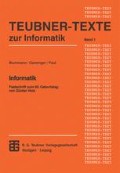Abstract
A major difficulty with logic programming is combinatorial explosion: since goals are solved with possibly indeterminate (i.e., branching) reductions, the resulting search trees may grow wildly. Constraint logic programming systems try to avoid combinatorial explosion by building in strong determinate (i.e., non-branching) reduction in the form of constraint simplification. In this paper we present two concepts, residuation and guarded rules, for further strengthening determinate reduction. Both concepts apply to constraint logic programming in general and yield an operational semantics that coincides with the declarative semantics. Residuation is a control strategy giving priority to determinate reductions. Guarded rules are logical consequences of programs adding otherwise unavailable determinate reductions.
Access this chapter
Tax calculation will be finalised at checkout
Purchases are for personal use only
Preview
Unable to display preview. Download preview PDF.
Bibliography
H. Aït-Kaci and R. Nasr. Integrating logic and functional programming. Lisp and Symbolic Computation, 2:51–89, 1989.
K. Clark. Negation as failure. In H. Gallaire and J. Minker, editors, Logic and Databases, pages 293–322. Plenum Press, New York, NY, 1978.
K. Clark and S. Gregory. PARLOG: Parallel programming in logic. ACM Transactions on Programming Languages and Systems, 8(1):l–49, 1986.
K. L. Clark and F. G. McCabe. The control facilities of IC-PROLOG. In D. Mitchie, editor, Expert Systems in the Micro-Electronic Age. Edinburgh University Press, Edinburgh, Scotland, 1979.
A. Colmerauer. An introduction to PROLOG III. Communications of the ACM, pages 70–90, July 1990.
A. Colmerauer, H. Kanoui, and M. V. Caneghem. Prolog, theoretical principles and current trends. Technology and Science of Informatics, 2(4):255–292, 1983.
M. Dincbas, P. Van Hentenryck, H. Simonis, A. Aggoun, T. Graf, and F. Berthier. The constraint logic programming language CHIP. In Proceedings of the International Conference on Fifth Generation Computer Systems FGCS-88, pages 693–702, Tokyo, Japan, Dec. 1988.
S. Haridi. A logic programming language based on the Andorra model. New Generation Computing, 7:109–125, 1990.
S. Haridi and S. Janson. Kernel Andorra Prolog and its computation model. In D. Warren and P. Szeredi, editors, Logic Programming, Proceedings of the 7th International Conference, pages 31–48, Cambridge, MA, June 1990. The MIT Press.
M. Höhfeld and G. Smolka. Definite relations over constraint languages. LILOG Report 53, IWBS, IBM Deutschland, Postfach 80 08 80, 7000 Stuttgart 80, Germany, Oct. 1988. To appear in the Journal of Logic Programming.
J. Jaffar and J.-L. Lassez. Constraint logic programming. In Proceedings of the 14th ACM Symposium on Principles of Programming Languages, pages 111–119, Munich, Germany, Jan. 1987.
J. Jaffar and S. Michaylov. Methodology and implementation of a CLP system. In J.-L. Lassez, editor, Proceedings of the 4th International Conference on Logic Programming, Cambridge, MA, 1987. The MIT Press.
J. W. Lloyd. Foundations of Logic Programming. Symbolic Computation. Springer-Verlag, Berlin, Germany, 1984.
M. J. Maher. Logic semantics for a class of committed-choice programs. In J.-L. Lassez, editor, Logic Programming, Proceedings of the Fourth International Conference, pages 858–876, Cambridge, MA, 1987. The MIT Press.
L. Naish. Automating control for logic programs. Journal of Logic Programming, 3:167–183, 1985.
E. Shapiro and A. Takeuchi. Object oriented programming in Concurrent Prolog. New Generation Computing, 1:24–48, 1983.
Author information
Authors and Affiliations
Editor information
Editors and Affiliations
Rights and permissions
Copyright information
© 1992 B. G. Teubner Verlagsgesellschaft, Leipzig
About this chapter
Cite this chapter
Smolka, G. (1992). Residuation and Guarded Rules for Constraint Logic Programming. In: Buchmann, J., Ganzinger, H., Paul, W.J. (eds) Informatik. TEUBNER-TEXTE zur Informatik, vol 1. Vieweg+Teubner Verlag, Wiesbaden. https://doi.org/10.1007/978-3-322-95233-2_24
Download citation
DOI: https://doi.org/10.1007/978-3-322-95233-2_24
Publisher Name: Vieweg+Teubner Verlag, Wiesbaden
Print ISBN: 978-3-8154-2033-1
Online ISBN: 978-3-322-95233-2
eBook Packages: Springer Book Archive

